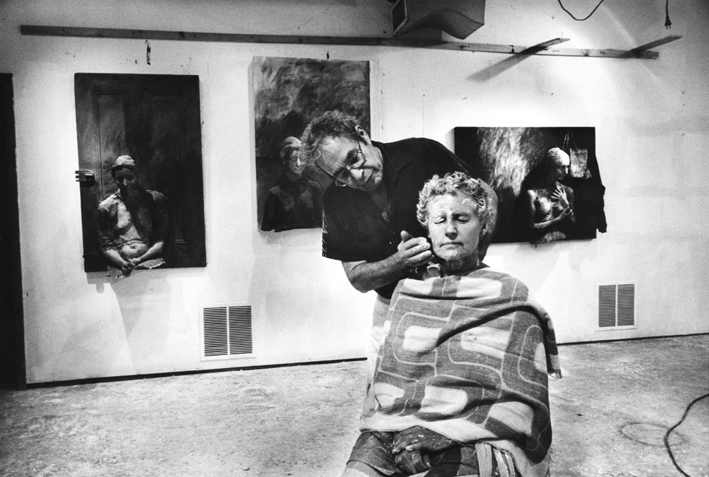PRESS RELEASE – 30 September 2010
A film documenting the symbolic burial of Patrick Ireland, the alter ego of the distinguished Irish artist Brian O’Doherty, will be launched at the Irish Film Institute at 7.00pm on Friday 8 October 2010. The Dying of Patrick Ireland is made by Loopline Film and is directed by Sé Merry Doyle. The film is produced by Vanessa Gildea and financed by the Irish Film Board and Loopline Film.
On 20 May 2008, after 36 years of making art as Patrick Ireland, Brian O’Doherty reclaimed his birth name with the burial of his alter ego in the grounds of IMMA. The burial was a gesture of reconciliation to celebrate the restoration of peace in Northern Ireland, just as his action in assuming the name Patrick Ireland was a protest at the British military presence in Northern Ireland and the failure of the authorities to ensure civil rights for all.
During the Irish Exhibition of Living Art at the Project Arts Centre in 1972, O’Doherty, in a performance before 30 invited witnesses and assisted by Robert Ballagh and Brian King, undertook to "sign his artworks Patrick Ireland until such time as the British military presence is removed from Northern Ireland and all citizens are granted their civil rights." This commitment, often seen as controversial, the artist described as "an expatriate’s gesture in response to Bloody Sunday in Derry."
Born in Ballaghadereen, Co Roscommon, Brian O’Doherty variously exhibited in the Irish Exhibition of Living Art and in the RHA and Oireachtas exhibitions from 1950 to 1956. He moved to the United States in 1957, where he became a pioneer in the development of conceptual art and also a renowned writer and critic. He has had several retrospectives, most recently in New York University’s Grey Gallery. His work has been seen in Documenta, the Venice Biennale, and Rosc. He is represented in the collections of the Metropolitan Museum and the Museum of Modern Art in New York, the Smithsonian American Art Museum in Washington and the Centre Pompidou in Paris. The influence of his ground-breaking collection of essays Inside the White Cube continues to this day.
Commenting on the film, director Sé Merry Doyle said: “I first came across the names Brian O’Doherty/Patrick Ireland in 1974 when I worked at the Project Arts Centre. Even two years after the event had taken place people were still talking about Brian O’Doherty’s historic name change. When the news broke that 34 years later he was going to change his name back to Brian O’Doherty I felt compelled to document this. The film is not so much a documentary as a document for the ages. It is a document that I hope will throw light on one of the most important political art statements to come out of Ireland.”
The launch coincides with the gift to the Irish Museum of Modern Art by Brian O’Doherty and his wife, the art historian Barbara Novak, of more than 70 artworks from their own collection. An exhibition of the donated work Post-War American Art: The Novak/O’Doherty Collection, is on show at the Irish Museum of Modern Art until 27 February 2011.
Limited tickets to the launch are available to the public online at www.imma.ie.
Additional screenings of The Dying of Patrick Ireland will take place at IMMA at a later date. These screenings will be open to the public. For further information visit www.imma.ie.
The Dying of Patrick Ireland
Director: Sé Merry Doyle
Producer: Vanessa Gildea
Executive Producer: Martina Durac
Editor: Sé Merry Doyle
Director of Photography: Paddy Jordan
Original Music: Lance Hogan (Kíla)
Financiers: Bord Scannán na hÉireann/ The Irish Film Board and Loopline Film
Duration: 50 minutes
For further information and review copies of the documentary please contact Patrice Molloy or Vanessa Cowley at Tel: +353 1 612 9900; Email: [email protected]
30 September 2010
 George Segal Preparing to Cast Barbara Novak for "Street Crossing" 1992. Documentation photograph. Photograph by Donald Lokuta
George Segal Preparing to Cast Barbara Novak for "Street Crossing" 1992. Documentation photograph. Photograph by Donald Lokuta